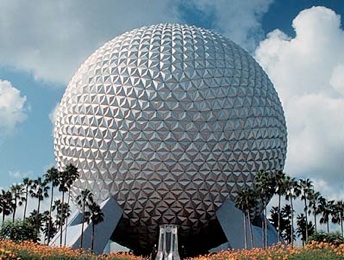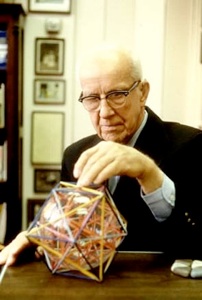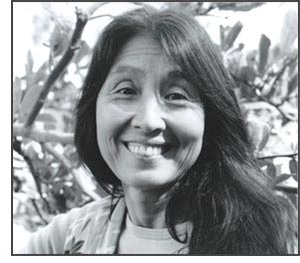Thomas McCain sample articles Pg 2
Published internationally

Thomas McCain sample articles Pg 2
Published internationally


VISIONARY MASTER OF STRUCTURE
BUCKMINSTER FULLER 1895-1983
“ABOARD SPACESHIP EARTH”
PART ONE
By Thomas McCain
October 1991
(All right reserved)
"It was in 1927 that I had this really extraordinary experience, the only one that ever happened to me that was really and utterly mystical. At that time Henry Ford was exhibiting his Model A down at the Armory, having switched from the Model T. So I walked down from Belmont Avenue to Michigan Avenue when suddenly I found myself with my feet not touching pavement; I found myself in a sort of sparking kind of sphere. I couldn't believe it. And heard a voice, such as I had never heard ever before, saying, "From now on you need never await temporal attestation to your thought. You think the truth." I couldn't believe I was not touching the ground that I was hearing this extraordinary thing. It was after that I started writing feverishly. I said, "I think I must write everything down because I was thinking the truth."
The man is R. Buckminster Fuller - half-blind, near-deaf inventor, mathematician, historian, planetary architect, visionary and one of the few souls on the earth who talked with Albert Einstein on that intimidating mathematical wavelength where mass divinizes at the speed of light. He visited India several times, befriended Nehru and his daughter Indira Gandhi and relished the esoteric teachings of yogic seer Sri Aurobindo. Hindus who dialogued with him personally, such as architect Vyom Akhil, happily welcome the sagely octogenarian as an "honorary Hindu." Fuller, to them, was one of the few great science minds that unequivocably insisted on the Vedic view that God, creation and energy are one.
My “Encounter” with “Bucky” in 1967
I personally met “Bucky” and spent three days with him when he came to my international private high school, Verde Valley School, Sedona, Arizona. a magical place, in 1968. This was before Sedona was abducted by the New Age herd who decided Sedona was a “An Earth Vortex Center of the Universal Cosmic/Galactic Energy” and one of six pivotal “energy axis points on earth.” When I schooled there, Sedona was nothing, I went there four times in three years, It had one gas station with a grocery store and one motel, the Turtle Inn. Our school was ten miles away in Oak Creek Canyon, now the home of billionaire internet moguls I hear. Then it was just a deserted desertscape with those world-famous orange/red sedimentary bluff/rock buttes, some cactus lizards “gulches” carved into the terrain by sudden rains which used them as drainage troughs to the Oak Creek or elsewhere,,,,,and a night sky like a Disneyland planetarium.
Bucky arrived one day with zero fanfare. It was lunchtime. His name rang no bell. He was a “guest speaker” and dear friend of my headmaster, Cornelius Bull. Both were New Jersey Princetonians and showed a visible mutual respect. Bucky was three generations older. Neil was a 40-year-old, firebrand educationist, cosmopolitan with movie-star looks.
Bucky was, in contrast, the octagenarian and fearless prober of Infinity –and where it touches reality– walking beside the down-to-earth straight-talking Cornelius. I was appointed his “host” for three days! Most people “can’t take him”–i.e. withstand his genius/nerdiness for more than five minutes, whether from an audience seat or beside him at the dining table. To me, I immediately senses he was anchored in a deep realm, an angelic alien. I needed no introduction to detect in his eyes and movements a “mind” spinning at light-speed machinations. I loved every minute being his “eye-seeing” dog... yes, he really is so near-sighted, his Coke bottle glass lenses make his eyes appear like uncanny orbs and scary to most. He talks. He talks a lot. A really lot. Not mindless. No. He follows his own track of thought decisively. You follow, or take your leave. He is not a conversationalist. He orates. In person, he is affable, laughs and, for most, totally hilarious to be around. His lightning bulb brain flaring up with each new concept shared, as though he himself were as excited
by his own ongoing momentary discoveries as those around him stared and raced to keep up with his scientific soliloquies.
“What did I learn?”
I was only 17. I had no clue about infinity as something to study or find application of,
and personally I was set on being a sculptor. Perhaps his geodesic dome forumal and
its replication of a universal strucutral building block did impress me, but I saw photos of it used by the military for quick construction. The military complex using his geniuses for war
ideology echoed of Einstein’s E=Mc2 being employed for war not peace. So this felt sad as Fuller’s efforts were to offer inventions for peace, not warring.
During these days with him, his eyes always sparkled with the enthusiasm of a kid, not a scientific genius. Our school was uplifted by this “alien landing” and none of us forget him. At age 41, when I decided to do this feature, four-part series, I read six of his most important works, every scrap of biographical information on him, but with each word, I remember being with him for those three days and knew that when he used the word “infinity” he felt it. Like someone who could reach into the sky and say, “This cloud is wet!” Or put his hand around the sun, and say “You see, I can touch the sun and my hand isn’t burned is it!?” With this personal flashback said, I continue.....
To most though "Bucky" remains that infatuated lover of the triangle. It was he who sired those unearthly-looking, sky-bubbles called "geodesic domes," made from four-sided crystal-like triangles called tetrahedrons, "nature's purest shape," he insisted. Famous for "enclosing the greatest volume with the least surface." 300,000 domes have mushroomed up around the world - from the Arctic tundra, to downtown Moscow, to Hawaii where a 120-footer was assembled in 32 hours.
By the time he died at 87 in 1983, this salty New Englander was something akin to what the Japanese claim as a "national living treasure," a person of such extraordinary worth - such as a great monk or calligraphy master - they are deemed irreplaceable. Bucky became an international treasure, prized as an oracle of sorts. Nation jealously ballied him about the globe like the Kohinoor diamond ever desirous for his dazzling ability to diagnose their economic dilemmas as though he were a hundred years in the future advising them where advanced intelligence and technology would best lead them. He talked spontaneously - in nuclear-charged thought clusters - with ever the look of a giant dam about to burst. Sometimes, so inspired by his own ideas, he would carry on until one person was left and the sun was rising.
Through glasses uselessly thick, he squinted before halls of world leaders commanding they trash medieval building designs - especially the cube - that exacted criminal waste of resources and labor. For structural support, use the triangle more - employ tensegrity (tension integrity) geometry instead of primitive right angles. The sun, sea urchin, crystal and universe use the efficient tetrahedron. Wake up! Be economical. He told nations to re-envision themselves synergistically part of a larger organism, earth. He tutored them to give up laying down bigger concrete roads. Use the air more, and accelerated rail technology like Japan. Cities as we know them - underoxygenated, swarming bogs of human mass - are obsolete, created by a manufacturing frenzy that needed everybody at ear and eye range. Sophisticated communications have obviated that need; factories and assembly plants can return to rural settings, allowing the human instinct to congregate for educative/cultural ends.
Education is the future industry on the planet, he saw. Invest in it. Specialization - insular, myopic and distorting - will give way to cross-bred engineers. "Scientists who once said they brought order out of chaos," will discover that all that was chaotic was their own mind, he repeated. Science will again glorify the "exquisite orderliness and comprehensive integrity of nature." To individuals he advised to guard against organized religion and all forms of dogma; listen instead to the inner voice fearlessly. He prophesied all major enlightened change on the planet will come from private initiative - unencumbered individuals who dare manifest inner calling - and not from government, which he saw in its present form suffocated by self-serving inertia. Women, more intuitive than men he felt, will emerge as the guiding influence in a warless world awakened from an eon of aggression mentality, male-dominated. He insisted there was no energy crisis - "The only crisis is an ignorance crisis" and saw wind and solar power would emerge the best energy sources.
Past and Present Life Asian Link
He felt a deep affinity with Asia, studied and wrote about it extensively, especially in his final treatise, Critical Path. "Humanity and civilization came from Indonesia," sailed northward up to India and Japan and around the globe, he taught. He studied Sri Aurobindo, excitedly underlined his most stirring cosmic passages and read them to Western audiences. He met India's dignitaries and Kashmir's heir prince Karan Singh. Nehru once sat in Fuller's presence for an hour and a half and never spoke a word until the end when he numaskared and confided, "I read everything of yours I can find," Indira Gandhi cried at Fuller later said she Einstein were the only two people so devoid of selfish ambition that he could see they received help from Higher Force. He believed in telepathy. His daughter, before she died at four, would speak out his thoughts. "There is something like telepathy going on around us which I am convinced will ultimately be identified as ultra-ultra-high frequency electromagnetic waves." To a Melanesian island chief. Fuller confided that he remembers being a Maori navigator/priest in a past life. (A keen sailor in this life, he named his sloop Naga after the Indian snake god.)
When he passed from earthscape in 1983, he was giving a major keynote address every three days, had been in print, radio or on TV 90,000 times, had indelibly etched his "spaceship earth" global-family mentality into the hearts of the children of the dawning millennium and gifted the planet thousands of drawings, inventions and visions of how to practically rebuild and pattern itself when it commits to livingry, not weaponry, intelligently sharing, not fighting for, the world's manifold resources.
"God is a Verb, Not a Noun!"
Born in Massachusetts to a rugged line of individualists, abolitionists, Transcendentalists - his aunt was editor of Emerson's writings - "Bucky" was eight when the Wright Brothers flew their plane at Kitty Hawk, "environment" still meant your home and the universe was divided into Euclidean cubes. Numbers came easy to Fuller. He could orchestrate symphonies of digits in any key - calculus, vector geometry or quantum physics. Harvard added little to his mathematical mind. Bored, he left - actually got himself dismissed for rendezvousing with a beautiful showdancer in New York City during exams. Meeting Einstein was thrilling. "He had an aura, an almost mystical aura around him," Fuller recalls and revered E=MC2 more than the mass=energy master himself. E=MC2 to the young, rebellious engineering maverick was sunlight direct from God, finally come to burn into oblivion a moldy and nescient Newtonian world, paralyzed by a belief that "a body persists in a state of rest unless it is compelled to change..." Nonsense! Fuller, like Einstein, had wormed into the core of matter with the numbers screw and found that at the center of molecular life, light, atomic energy, was in furious motion. "Newton was a noun and Einstein a verb," Fuller yodelled. "Non-simultaneous physical universe is energy and energy equals mass times the second power of the speed of light. No exceptions. Fission verified Einstein's hypothesis. Change is normal! Thank you Albert," he barked with a bit of the pit-bull aggression that gained him a quarterback spot in high school football.
Mass. accelerated at the speed of light, energizes. "There are no solids!" Fuller fumed. All form is pure energy particles dancing at various speeds - rocks are slow dancers, gasses faster, thoughts faster. God the fastest. Einstein told friends his E=MC2 Close Encounter with God imparted a "cosmic religious sense," as he politely phrased it. Fuller teased the shy math rishi for so timidly tailoring such an earth-shattering realization. Fuller wasn't afraid of the scientific materialists or God-is-an-old man-in-the-sky Christians. If God dances, say it! "God is a verb, an abstract love-momentumed gyrocompass, not a noun - proper or improper," he bellowed to a deaf world just diving into World War II. To sense God gyrating at the core of form in titanic mechanical precision, speed and horsepower was explosive - an appreciation that Fuller, once a cotton-mill millwright, could totally appreciate. "...God, loving, not the abstract in love commanded or entreated, is knowledge dynamic, not legislative code, not proclamation law, not academic dogma, nor ecclesiastic canon. Yes, God is a verb, the most active, connoting the vast harmonic reordering of the universe from unleashed chaos of energy." His God-in-furious-motion universe clearly resonates the image of Shiva Nataraja, the Cosmic Dancer who pulsates all form from inside the atomic core of form.
Fuller sometimes referred to God as "the greater integrity" and especially liked the word synergy - cooperative action of a whole organism not predicted by the local behavior of its parts - and found it as applicable for the God/universe as for a new chrome/nickel/steel alloy, alluding to his Navy days as a creative shipbuilding engineer. "The universe is the comprehensive apriori synergetic integral, aggregate system embracing all men's consciously apprehended and communicated experiences and continually operates in comprehensive, co-ordinate patterning," he wrote in No More Secondhand God. Basically, the entire universe is interconnected, permeated by a harmonizing principle, rita (universal) dharma, in Hindu parlance. "The common man ascribes all behaviors unpredicted by his statistical probabilities to "luck' and "miracle,'" Fuller noted. To him this was caveman ignorance. His God-synergized universe operates strictly on the sophisticated mechanics of karma, action and reaction, not luck - a generator of an action ultimately but faithfully receiving its reaction because the action never fully disconnected from the sender.
Two years before Fuller died, he wrote this heartfelt epistle to his fellow humans: "The effective decisions can only be made by the independently thinking and adequately informed human individuals and their telepathetically intercommunicated wisdom - the wisdom of the majority of all such human individuals - qualifying for continuance in Universe as local cosmic problem-solvers - in love with the truth and in individually spontaneous self-commitment to absolute faith in the wisdom, integrity, and love of God who seems to wish Earthian humans to survive."
Part I in a IV-Part Series.
“One Day a
Goddess Spoke”
Meeting Mayumi Oda
By Thomas McCain
May 1995

Then Hiroshima. "I was terrified by this news of hell-thousands of people evaporated or scorched to death. I did not know what to do. Later we folded Origami paper cranes, thousands of them, sending them to the Hiroshima Peace monument." War horrors finally faded into cherry blossom springtimes as Mayumi learned the three-stringed shamisen, carved horses out of twisted cucumbers for summer Obun festivals, listened to her scholar/father chant Buddhist sutras and talk about liberating the soul, read about the lives of extraordinary women and painted. "I can see myself sitting on the tatami mat floor with a new set of crayons my mother has just bought for me. The sliding paper doors to the garden stand open; the crayons are bathed in light. I begin to draw..." Passionately. She got into Japan's super-elite National Academy of Art, married an American, moved to California, had two sons, started meditating daily and painted blissfully. By 1988, she had earned world wide recognition, published a stunning autobiographical book, Goddesses, with silkscreened, frolicking female Divinities and dreamed of painting forever. But suddenly, by divine intervention, she stopped. Here is how it happened.
In 1991, Mayumi returned to Japan wanting to give back something to her land of birth. What she found saddened her. "My country has been quite a spiritual country. But I found the people drunk with material things. I also found out that my country was deeply committed to the use of plutonium for electricity and that we were about to ship 1.7 tons of plutonium (150 nuclear bombs worth) from France to Japan. I was dumbfounded. How could the country which experienced the atomic bomb do this? What could we do to stop this? So I visited Tenkawa Shrine on Omine mountain to pay homage to Sarasvati, Goddess of prosperity, creativity, art and music. The shrine is surrounded by a deep green cedar forest. In front of the shrine stood a huge ginkgo tree planted by Buddhist saint Kobo Daishi 1200 years ago [he installed the Deity here and also brought esoteric worship of Ganesha to Japan from China.] All its golden leaves were gone and the gingko stood completely naked with trememdous dignity.
"I went to the tree, opened my arms and hugged the tree. I could feel its pulse-zum, zum, zum. Amazing energy was coming from the roots which spread deep underneath my body. I felt so small and yet so connected to this tree and through this tree to the whole world. So I asked the tree, "What can we do?" Then on New Year's Day, 1992, meditating in front of a Saraswati figure, She appeared to me in a vision. She was sitting on a sail boat holding the globe in Her belly, surrounded by many kinds of wild animals and plants. I also heard a voice saying, "Stop the plutonium shipment." It seemed to come from the Goddess. I asked, "Why me? I am an artist." The Goddess said, "Help will be provided." The voice had irresistible power, so we formed a group called Plutonium Free Future."
For the last three years Mayumi has toiled indefatigably working with non-governmental organizations to ban the trade and use of an asuric substance so hostile to the earth and far too dangerous for a war-prone planet. Her otherworldly artist is now hibernating. Days are filled with business chores-faxing, phoning, petitioning, organizing and lecturing, especially to women. She tells them to claim their goddess-like strengths and become the new peacemakers and earth stewardesses, each in their own way. But still, "Once in a while I really want to be in my studio, by myself painting. A tear comes down my cheek and I say, `I am being asked to do this.' When I find someone else who can do this, I'll come back to my studio. People need art to soften their hearts." Address: c/o Inochi, P.O. Box 2589, Berkeley, California, USA 94702.
ADDENDUM: The following is taken from her personal website:
Known to many as the “Matisse of Japan,” Mayumi Oda has done extensive work with female goddess imagery. Born to a Buddhist family in Japan in 1941, Mayumi studied fine art and traditional Japanese fabric dying. In 1966 she graduatied from Tokyo University of Fine Arts. Mayumi’s unique apprenticeship dying fabric for kimonos influences the color and composition of all of her work.
From 1969 to the present Mayumi has exhibited over 40 one-woman shows throughout the world. Her artwork is also part of the permanent collections of the Museum of Modern Art - New York, The Museum of Fine Arts - Boston, Yale University Art Gallery - New Haven, Library of Congress - Washington D.C. and many others.
In addition to her work as an artist, Mayumi has spent many years of her life as a “global activist” participating in anti-nuclear campaigns worldwide. She founded Plutonium Free Future in 1992. On behalf of her organization, Mayumi lectured and held workshops on Nuclear Patriarchy to Solar Communities at the United Nations NGO Forum and the Women of Vision Conference in Washington DC. In 1999 she launched the WASH (World Atomic Safety Holiday) Campaign and is currently working to raise awareness among the citizens of Hawai’i about the use of Depleted Uranium at the Pohakuloa military base. Feeling a deep connection with the mother earth, Mayumi has always enjoyed growing her own medicinal herbs and vegetables. In 2000 she started Ginger Hill, a farm and retreat center on the Big Island of Hawai’i.The artistically landscaped 5-acre property is home to a number of workshops and retreats ranging from traditional Hawai’ian Hula to medicinal cooking.
Mayumi currently lives with her family at Ginger Hill Farm and travels worldwide, teaching workshops in creativity and self-realization.

“I spent four days with this extraordinary visionary in 1967 in Arizona and later researched four months reading all his writings and wrote this four-part article in 1991.”
–Thomas McCain